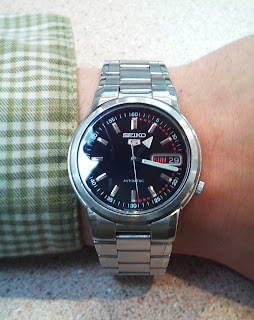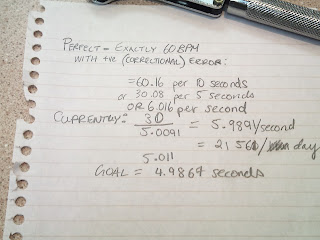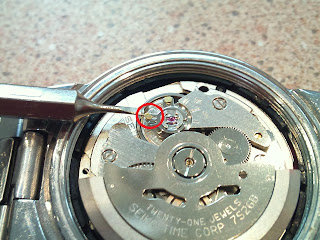Mechanical watches aren't yet relegated to the sidelines completely; there are still numerous companies manufacturing thrifty automatic watches in the $80-150 range. Possibly the best example of such a watch is my current timepiece, one from venerable the Seiko '5' line of watches. Unlike their quartz cousins, though mechanicals won't need batteries (and often don't need maintenance for over a decade), they
do need adjustment to keep accurate time. My Seiko, which came from the factory about 5 s/day fast, has settled into a consistent 30s/day slow. Not wanting to pay a watchmaker $30 to do something I am capable of, I set about to adjust the mechanism.
 |
Seiko 5 Auto-winding watch -
pretty bulletproof, and looks decent to boot |
Here's what you'll need:
- A mechanical watch
- A computer with Audacity or equivalent sound-recording program
- A microphone
- A quiet room
- A set of micro screw drivers/bits
- A magnifying glass (optional)
- A watch case opener - I got mine for a song at Active Surplus in Toronto
How to do it:
- Set it Up: Boot up your computer in a quiet room. Open up Audacity (or similar) and hook up a microphone. For me, I used my laptop's built-in microphone.
- Record: Place the watch face-first up to the microphone, with as much contact as possible so the quiet 'tick-tick' can be recorded clearly. Leave it recording for ~15 seconds.
- Edit and Noise Reduce: depending on your microphone, you may (like me) need to use noise-removal plugins to clean up the signal, and visually show clear bumps for each 'tick'. I also amplified the signal to make each point more noticeable.
- Select the midpoint of the first hump (see below), and delete all before that position, bringing it flush with the 0.00s position.
- Move forward to the 5-second position. Zooming in, check the time position for the last hump. It should be as close to being 5.00 seconds as possible. [Note: It *should* be a little under 5.00s, to compensate for knocks which will lose time]. If over 5.00s, your watch is running slow (losing time), and if under 5.00s, your watch is running fast (gaining time).
 |
Before adjustment: bump @ 5.0091s, After adjustment: bump @ 4.985s.
Slightly fast compensates for bumps & knocks through the day. |
- Crunch the Numbers: For my watch, it has a listed BPH of 21 600, meaning at 100% accuracy, it is supposed to 'tick' 21600/hour. Dividing that by (60s x 60mins) = 6 beats per second, or 30 beats per 5 seconds. However, I had a time of 5.0091s for 5 beats - a calculated loss of about 144 seconds per day (which is far more than actual).
- Determine the Goal: Usually, the goal is to set the actual BPH ahead by 10 seconds per hour, to compensate for odd watch angles and knocks which actually slow it down slightly through the course of a day. 10 seconds = 60 beats, so my goal BPH was 21 660BPH. Dividing by (60s x 60mins) = 6.0167 bps, or 30.0833 beats per 5 seconds. Therefore my goal for 30 'ticks' was: (30s / 30.0833) x 5s = 4.986s.
 |
| Set a goal based on your watch's BPH value |
- Adjust the Mechanism: If the watch band is metal, use a small screw tip bit, and release the watch band.
- Open the back of the watch with the watch opening tool.
- With a thing pointed screw driver and magnifying glass, tweak the adjuster of the hairspring on the balance wheel in the direction (+ or -) your timing needs to go. Be careful: this is the most delicate part of a watch, and also, a small adjustment goes a long way!
 |
Adjustment: be sure to only move the adjustable mount
for the hairspring (circled in red), and not the fixed mount. |
- Close up the watch backing, record another sound clip, and crunch the numbers to see if you've come close to your goal.
For me, I achieved 4.985s on my second try - very close to my 4.986s goal. The watch now runs about -2 seconds per day, meaning this entry-level watch surpasses
COSC standards!










Comments
Post a Comment